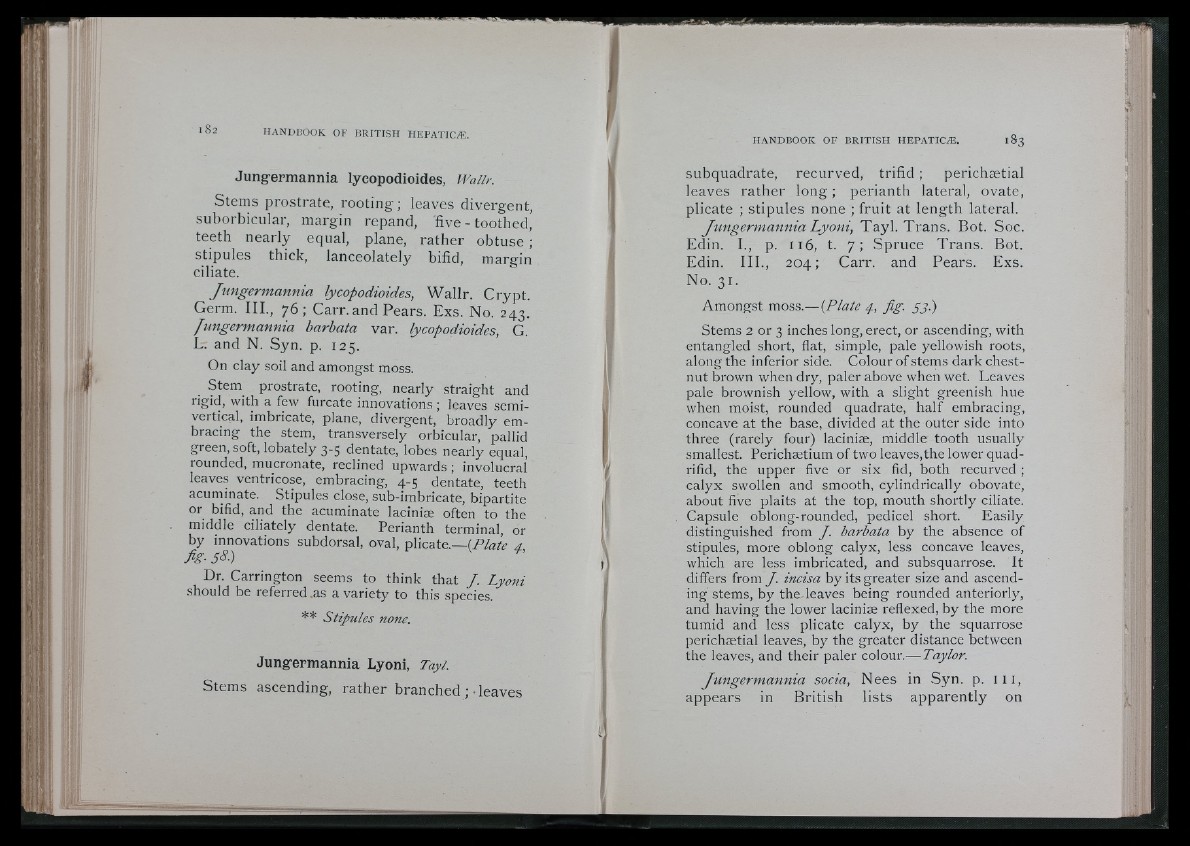
i
Jungermannia lycopodioides, lVa//r.
Stems prostrate, ro o t ing ; leaves divergent,
suborbicular, margin repand, five - toothed,
teeth near ly equal, plane, rather obtuse ;
st ipules thick, lanceolately bifid, margin
ciliate.
Jungermannia lycopodioides, Wa l lr . Cryp t .
Germ. III., 7 6 ; Carr, and Pears. Exs. No. 243.
fungermannia barbata var. lycopodioides, G.
L. and N. S yn. p. 125.
On clay soil and amongst moss.
Stem prostrate, rooting, nearly straight and
rigid, with a few furcate innovations ; leaves semivertical,
imbricate, plane, divergent, broadly embracing
the stem, transversely orbicular, pallid
green, soft, lobately 3-5 dentate, lobes nearly equal,
rounded, mucronate, reclined upwards ; involucral’
leaves ventricose, embracing, 4-5 dentate, teeth
acuminate. Stipules close, sub-imbricate, bipartite
or bifid, and the acuminate laciniæ often to the
middle ciliately dentate. Perianth terminal, or
by innovations subdorsal, oval, pY\cate.~[Plate 4,
fig- 5^-)
Dr. Carrington seems to think that J . Lyoni
should be referred as a variety to this species.
** Stipules none.
Jungermannia Lyoni, Tayl.
Stems ascending, rather branched ; leaves
.
/\
subquadrate, recurved, trifid ; perichæt ial
leaves rather long ; perianth lateral, ovate,
plicate ; st ipules none ; fruit at length lateral.
Jtmgermannia Lyoni, T a y l . Trans . Bot. Soc.
Edin. I., p. 116, t. 7 ; Sp ru c e Trans . Bot.
Edin. III., 204; Carr, and Pears. Exs.
No. 31.
Amongst moss.— {Plate 4, fig. g j.)
Stems 2 or 3 inches long, erect, or ascending, with
entangled short, flat, simple, pale yellowish roots,
along the inferior side. Colour of stems dark chestnut
brown when dry, paler above when wet. Leaves
pale brownish yellow, with a slight greenish hue
when moist, rounded quadrate, half embracing,
concave at the base, divided at the outer side into
three (rarely four) laciniæ, middle tooth usually
smallest. Perichætium of two leaves, the lower quadrifid,
the upper five or six fid, both recurved ;
calyx swollen and smooth, cylindrically obovate,
about five plaits at the top, mouth shortly ciliate.
Capsule oblong-rounded, pedicel short. Easily
distinguished from / . barbata by the absence of
stipules, more oblong calyx, less concave leaves,
which are less imbricated, and subsquarrose. It
differs from J. incisa by its greater size and ascending
stems, by the leaves being rounded anteriorly,
and having the lower laciniæ reflexed, by the more
tumid and less plicate calyx, by the squarrose
perichætial leaves, by the greater distance between
the leaves, and their paler colour.— Taylor.
appears m
socia, Nees
Brit ish lists
in S yn. p. 1 1 1 ,
apparent ly on